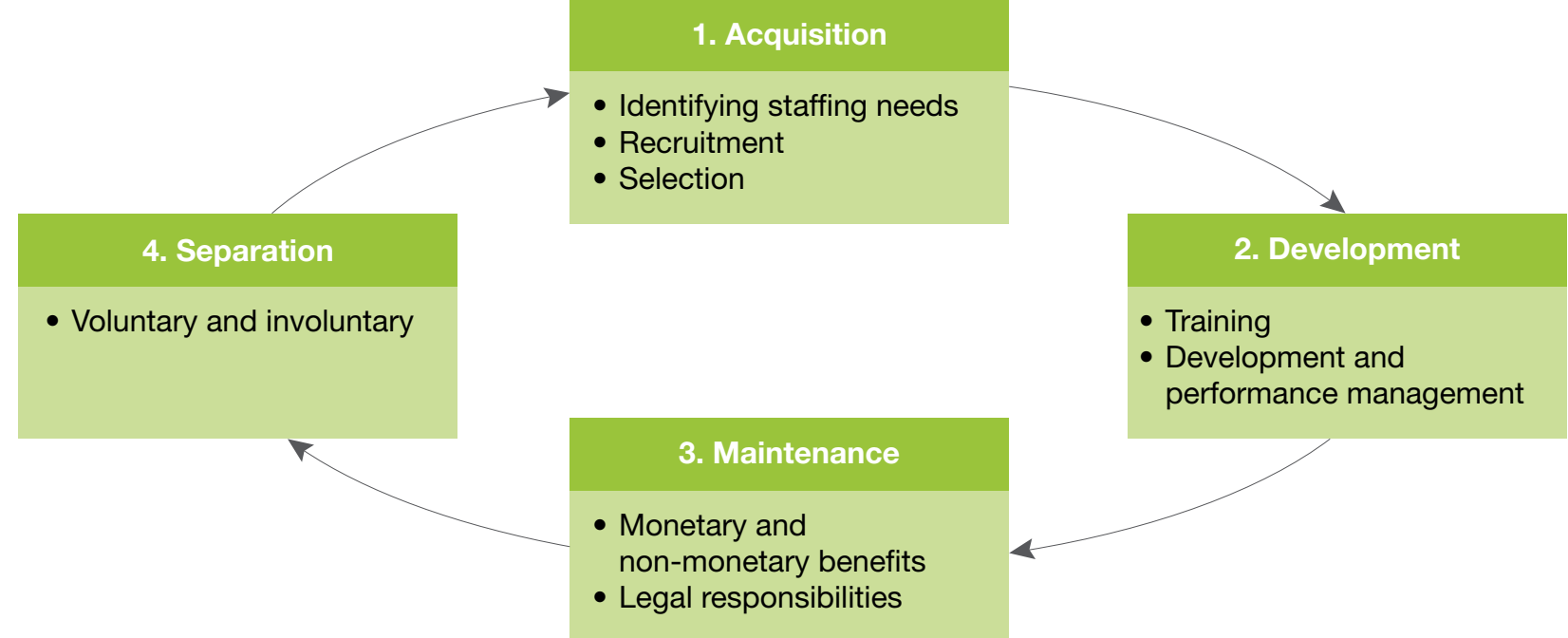Photo AI
Last Updated Sep 24, 2025
Staff Turnover & Absenteeism Simplified Revision Notes for SSCE HSC Business Studies
Revision notes with simplified explanations to understand Staff Turnover & Absenteeism quickly and effectively.
325+ students studying
Staff Turnover & Absenteeism
Definition of Human Resource Management (HRM)
- Human Resource Management (HRM): is responsible for managing the organisation's workforce through established policies and technology solutions.
- Examples include integrated HR software and AI-enhanced recruitment processes.
- HRM has evolved from focusing solely on administrative duties to becoming a strategic partner due to the influences of globalisation and workforce diversity.
Objectives and Impact of Effective HRM
- Objectives of HRM:
- Enhance employee satisfaction.
- Cultivate a positive organisational culture.
- Align workforce resources with business objectives.
- Impact of Effective HRM:
- Increased productivity: Efficient workflows result in improved output.
- Reduced turnover: Adaptive policies increase employee retention.
- Cost efficiency and higher engagement: Fostered by a positive workplace atmosphere.
Research indicates that adaptable HR practices, such as flexible scheduling, reduce turnover while significantly enhancing productivity.
- Example: Companies like Google and Zappos exemplify effective HRM by fostering vibrant cultures that stimulate innovation and enhance retention.
Staff Turnover and Absenteeism as Indicators
Staff Turnover: Definition and Impacts
- Staff Turnover: A measure of the rate at which employees depart from an organisation over a specific period.
- Types of Turnover:
- Voluntary Turnover: Occurs when employees choose to leave the organisation. Example: Resignation for better opportunities.
- Involuntary Turnover: Occurs when employees are dismissed by the employer. Example: Layoffs due to budget reductions.
Voluntary Turnover: Employees elect to leave (e.g., resigning for better job opportunities). Involuntary Turnover: Employer-initiated dismissal (e.g., layoffs due to budget constraints).
Impact of High Turnover
- Disruption: High turnover disrupts operations and workflow.
- Morale: Detrimentally affects employee morale and decreases productivity.
- Costs: Increases expenses for recruitment and training.
- Knowledge Loss: Leads to gaps in organisational knowledge.
The loss of experienced staff creates gaps in organisational knowledge and raises costs related to recruitment and training.
Calculation of Turnover Rate
- Formula:
- Example: If 15 out of 150 employees depart over the year:
- Turnover Rate:
Visualising Turnover Trends
- Use graphs to show turnover patterns over intervals.

Causes of Staff Turnover
Internal Causes
-
Recruitment and Onboarding:
- Issues: Suboptimal recruitment practices and role mismatches.
- Solutions: Strengthen training programmes and enhance mentoring.
-
Career Advancement:
- Absence of transparent progression paths demotivates staff.
- Strategy: Develop clear career paths and conduct regular promotion evaluations.
-
Workplace Culture:
- Toxic environments contribute to turnover.
- Remedy: Create an inclusive work atmosphere through team-building activities.
External Causes
-
Economic Factors:
- Recessions and competitive offers can exacerbate turnover.
- Strategy: Modify compensation packages in accordance with market trends.
-
Leadership and Management:
- Challenges: Micromanagement and insufficient development programmes.
- Strategy: Foster flexible and responsive leadership approaches.
Summary Diagram

Strategies to Reduce Staff Turnover
Strategic Interventions
- Competitive Compensation
- Ensure that salaries reflect industry standards.
- Mentorship and Career Development
- Introduce mentoring protocols and establish career paths.
- Positive Workplace Culture
- Nurture a supportive and inclusive environment at the workplace.
Effective Motivation Strategies
- Work-Life Balance Initiatives
- Offer flexible working hours and remote work options.
- Employee Recognition Programmes
- Customise recognition and advancement opportunities.
Introduction to Absenteeism
Definition & Context
Absenteeism: Represents the chronic absence of employees from their duties. It is a substantial indicator of HRM effectiveness.
Impact on Business
- Reduced Productivity
- Increased Operational Costs
- Lowered Team Morale
Causes of Absenteeism
Internal Factors
- Health-Related Issues
- Includes chronic illnesses and mental health challenges.
- Workplace Stress and Culture
- Workplace stress and toxic conditions can heighten absenteeism.
External Factors
- Economic Conditions
- Personal Circumstances
- Challenges with work-life balance can lead to absenteeism.
Visualising Causes

Absenteeism Reduction Strategies
Flexible Work Schedules
- Customise work hours to boost attendance.
- Mitigate burnout by enhancing work-life balance.
Implementation Steps
- Assess Roles
- Develop Policies
- Communicate Effectively
- Pilot Implementation
- Gather Feedback and Adjust
Case Study: Successful Implementation
- Example: Company X slashed absenteeism by 30% using flexible scheduling.
Visual Summary of Turnover & Absenteeism
Venn Diagram

Shared Characteristics
- Workplace culture impacts both turnover and absenteeism.
- Economic conditions influence both turnover and absenteeism differently.
Monitoring Tools and Techniques
HR Analytics
- Leverage tools for employee monitoring and predictive insights.
- Surveys and benchmarks provide clarity on HR trends.
Visualisation Methods

Implementing various HR strategies targeting both turnover and absenteeism can enhance overall workplace effectiveness and morale.
500K+ Students Use These Powerful Tools to Master Staff Turnover & Absenteeism For their SSCE Exams.
Enhance your understanding with flashcards, quizzes, and exams—designed to help you grasp key concepts, reinforce learning, and master any topic with confidence!
160 flashcards
Flashcards on Staff Turnover & Absenteeism
Revise key concepts with interactive flashcards.
Try Business Studies Flashcards20 quizzes
Quizzes on Staff Turnover & Absenteeism
Test your knowledge with fun and engaging quizzes.
Try Business Studies Quizzes19 questions
Exam questions on Staff Turnover & Absenteeism
Boost your confidence with real exam questions.
Try Business Studies Questions19 exams created
Exam Builder on Staff Turnover & Absenteeism
Create custom exams across topics for better practice!
Try Business Studies exam builder24 papers
Past Papers on Staff Turnover & Absenteeism
Practice past papers to reinforce exam experience.
Try Business Studies Past PapersOther Revision Notes related to Staff Turnover & Absenteeism you should explore
Discover More Revision Notes Related to Staff Turnover & Absenteeism to Deepen Your Understanding and Improve Your Mastery
96%
114 rated
Effectiveness of human resource management
HRM: Accidents & Disputes
429+ studying
190KViews96%
114 rated
Effectiveness of human resource management
HRM Effectiveness
263+ studying
191KViews96%
114 rated
Effectiveness of human resource management
HRM and Worker Satisfaction
467+ studying
197KViews